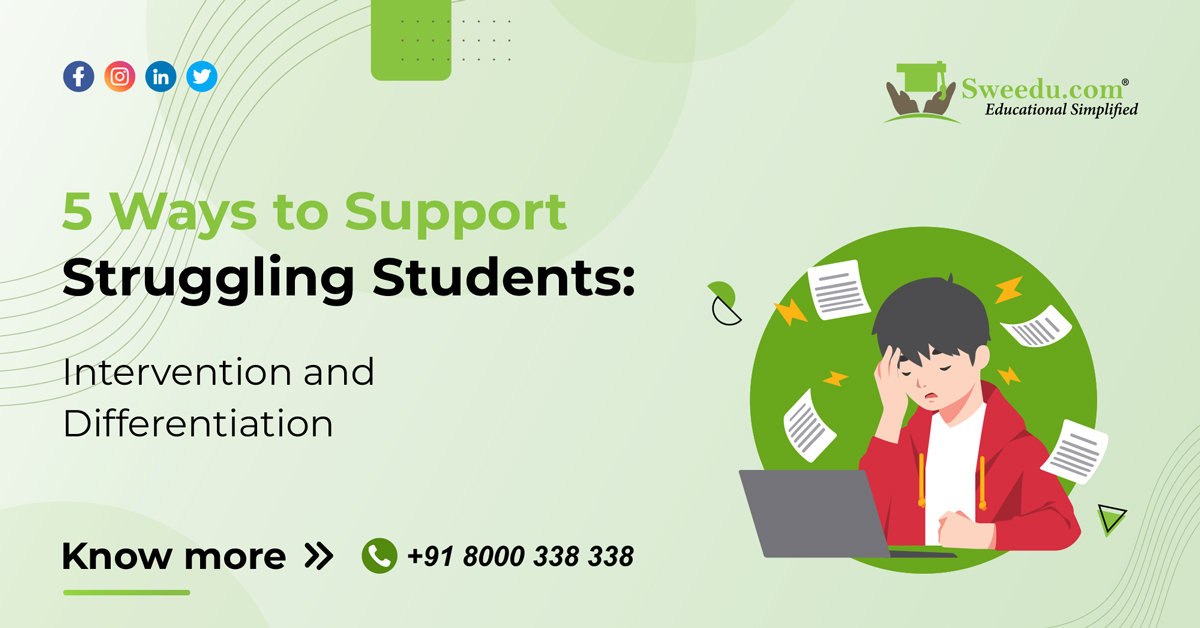
Every student learns at their own pace and in their own way. But some students need a little extra help to perform well in school. This is where intervention and differentiation come in.
Intervention and differentiation are two strategies that teachers can use to help struggling students reach their full potential.
What is Intervention?
Intervention is targeted instruction that is provided to students who are struggling in a particular area. It can be provided individually, in small groups, or as part of a whole-class lesson. Examples of interventions involve extra practice, using specialized materials, or modifying homework assignments.
What is Differentiation?
Differentiation is a process wherein a teacher modifies their classroom assignments, and other instructions to meet the needs of all types of learners. This can be done by assigning different levels of classroom instructions as per their difficulty, offering students various learning opportunities, and allowing them to participate as per their own pace and not at the same pace as the classroom.
Why Every Teacher Needs Intervention and Differentiation?
These two teaching strategies are a must for teachers who want to create a classroom for where all students learn instead of some. By customizing their classroom learning methods as per their students, teachers can do so successfully.
Practical Examples of Intervention and Differentiation
-
Intervention:
Problem: A student is struggling with math, dyslexia, or a learning disability.
Solution:
A teacher can provide one-on-one tutoring, use a specialized computer program, or modify a test to help the student overcome their challenges.
Differentiation:
Problem: Students are struggling to stay engaged in their science projects because they all have to complete the same project in the same way.
Solution:
The teacher provides students with a choice of how they want to complete the project. This could involve giving students different project options, allowing them to choose their own research topics, or letting them decide how to present their findings.
Five Ways to Implement Intervention and Differentiation
-
1. Identify students’ needs
The first step to supporting struggling students is to identify their needs. Teachers can spot struggling students through assessments like tests, quizzes, observations, and one-on-one talks. Once they identify these areas of struggle, they can implement intervention and differentiation strategies.
Example:
If you notice that several students in your class are struggling to write paragraphs, you can give them a short writing assignment to assess their skills. Analyzing the assignment’s results will reveal each student’s areas of weakness, allowing you to tailor interventions accordingly.
2. Provide targeted interventions
These interventions aim to help students improve in areas where they struggle. While choosing an intervention method, it is important to consider the student’s specific needs or problems and their preferred learning style.
Example:
As a teacher, if you find a student struggling with grammar you can either help them with one-on-one tutoring or provide them with materials that they can refer to work on grammar errors in their writing.
You can also use group interventions to help students improve their common pain points like their writing skills. You can teach them how to brainstorm ideas, organize their thoughts, and write a strong conclusion.
3. Differentiate Instruction
By using different learning methods, teachers can personalize learning for their classroom. These methods can include creating study materials for students with different levels of difficulty, providing multiple learning resources, or allowing students to have a say in their classroom learning activities.
Example:
You can allow students to make the choice of how they want to complete a history project, choosing the deadlines, and even the method of presentation [report, video, or presentation].
4. Provide support outside the classroom
Teachers can support struggling students both within and beyond the classroom.
Teachers can offer additional support for any students outside the class who are struggling with their studies. They can also communicate with parents to make sure that their students are supported well at home.
Example:
If you notice that a student is struggling in math, you can offer them to help them with a tutoring program. The tutoring program could be one-on-one or peer-based as per the student’s preference.
5. Create a positive and supportive learning environment
All students need to feel safe and supported in order to learn. Teachers who take the time to understand their students’ individual needs and learning styles can create a more supportive and engaging classroom.
Example:
If you greet each student by name at the beginning of the day, create a classroom culture where students feel comfortable asking for help and making mistakes, you can create a positive and supportive learning environment.
FAQ’s
1, What are some interventions for struggling students?
Support struggling students by providing more specific guidance, using different teaching methods, modifying day-to-day lessons to their needs, creating a supportive learning environment, and involving parents in the learning process.
2, How do teachers support struggling students?
Teachers can adjust the pace of instruction to meet the needs of individual students in a classroom.
-
3. How do you differentiate struggling learners?
To differentiate struggling learners, monitor classroom performance, analyze standardized test scores, conduct individual assessments, seek teacher input, observe student interactions, review student work, conduct parent-teacher conferences, and seek input from specialists.
-
4, What strategies will you recommend for students struggling?
To help struggling students thrive, provide personalized instruction, offer support, create a positive classroom environment, and involve parents.
EndNote
Providing support for struggling students is crucial for effective teaching. Implement the strategies in this blog to create a supportive learning environment that helps all students succeed.
Remember, every student learns differently. Differentiate instruction and provide targeted interventions to ensure everyone has the opportunity to succeed.
Education ERP systems can further support struggling students. Try SWEEDU ERP with a free trial demo today.





